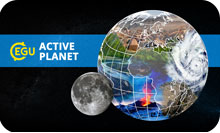Some miscellaneous observations from the 2016 General Assembly of the European Geosciences Union in Vienna . . . .

Major Concepts = Excellent Session
I participated in a paper session called “Beyond the Case Study: Concepts in Earth Sciences.” Geosciences are of course built on case studies, and without them we would have no useful or interesting theories, hypotheses, syntheses, or conceptual frameworks. But in a professional meeting context you get a bit tired of sitting through the detailed results from yet another watershed monitoring study, lab experiment, numerical model, paleoenvironmental reconstruction or what have you. Unless these things are dead on your own interests, it is much more interesting to be challenged by some big ideas and overarching concepts and themes.
That’s what this session was all about, and it went well. It is rare—in fact I can’t remember the last time—I sat through six presentations in a row that all held my full attention from start to finish.
I wish more scientists would step out with their big ideas, and I hope there are more sessions like this one to encourage that. Take it from me, it doesn’t hurt that much when you get challenged or criticized for them, and you might as well (to strain a baseball metaphor) strike out swinging for the fences as ground out just trying to make contact.
Micha Dietz put together the session, along with Jacky Croke, Maggie Fuchs, and Kevin Norton.
Graph Theory
The only other time I’ve attended EGU was in 2012. At the time I was looking to connect with others applying graph theory in geomorphology, and I only turned up two—Wolfgang Schwanghart and Tobias Heckmann, both from Germany. I met them for lunch, and our jointly authored reviews of graph theory in geomorphology and geosciences arose from that meeting.
Four years later, graphs and networks are all the rage in geomorphology (and other geosciences represented here). It’s great to see how many new applications are being developed, and the potential for so much more. It’s also humbling, as it was the first time I met Wolfgang and Tobias, to see how much better some people are at it than I am.
Connectivity and Tipping Points
Geomorphologists and hydrologists have long been concerned with issues of water and sediment connectivity—whether, how, how much, and how often fluxes occur between various locations and hydrogeomorphic entities. Less than a decade ago, however, connectivity became a major buzzword not just for scientists, but also managers and engineers as a broader community became aware of its importance for issues such as water quality and aquatic and riparian ecology.
This EGU meeting featured an entire day of geomorphological connectivity papers, some of which were simply traditional geomorphic topics packaged as connectivity (after all, what study of mass fluxes and transport does not address connectivity in some fashion?), and some of which addressed emerging issues in connectivity (including application of network and graph theory). Still, one of the principle figures in the rise of the connectivity framework (I won’t mention the name because they didn’t know they might be quoted) indicated that they were getting pretty sick of it all.
Yeah, I understand that. But right now, connectivity sells in terms of grabbing attention, and we should not hesitate to use the term if it fits to get attention. The same goes for Tipping Points. Stuart Lane gave a presentation pointing out (among other things) that the idea of TPs has no “value added” for geomorphology, as everything it includes are already covered, and less ambiguously, by existing concepts.
But tipping point terminology is already out there, prominent in environmental discourse, so why not use it to gain attention, or funding (in conversation later, by the way, Stuart totally agreed)? Having said that, I presented a poster here on tipping points, am part of a funding proposal under review on the topic, and have previously blogged about it.
At the very least, several of us agreed that someone should start a pub called Tipping Pints. It was funnier if you were there.
